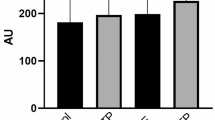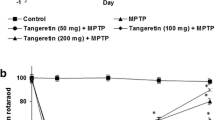Abstract
We have recently demonstrated that rodents treated intranasally with 1-methyl-4-phenyl-1,2,3,6-tetrahydropyridine (MPTP) suffered impairments in olfactory, cognitive and motor functions associated with time-dependent disruption of dopaminergic neurotransmission in different brain structures conceivably analogous to those observed during different stages of Parkinson’s disease (PD). On the other hand, the proanthocyanidin-rich fraction (PRF) obtained from the bark of Croton celtidifolius Baill (Euphorbiaceae), a tree frequently found in the Atlantic forest in south Brazil, has been described to have several neurobiological activities including antioxidant and anti-inflammatory properties, which may be of interest in the treatment of PD. The present data indicated that the pretreatment with PRF (10 mg/kg, i.p.) during five consecutive days was able to prevent mitochondrial complex-I inhibition in the striatum and olfactory bulb, as well as a decrease of the enzyme tyrosine hydroxylase expression in the olfactory bulb and substantia nigra of rats infused with a single intranasal administration of MPTP (1 mg/nostril). Moreover, pretreatment with PRF was found to attenuate the short-term social memory deficits, depressive-like behavior and reduction of locomotor activity observed at different periods after intranasal MPTP administration in rats. Altogether, the present findings provide strong evidence that PRF from C. celtidifolius may represent a promising therapeutic tool in PD, thus being able to prevent both motor and non-motor early symptoms of PD, together with its neuroprotective potential.








Similar content being viewed by others
References
Adachi N, Tomonaga S, Tachibana T, Denbow DM, Furuse M (2006) (-)-Epigallocatechin gallate attenuates acute stress responses through gabaergic system in the brain. Eur J Pharmacol 531:171–175
Allain H, Bentué-Ferrer D, Akwa Y (2008) Disease-modifying drugs and Parkinson’s disease. Prog Neurobiol 84:25–39
Archer J (1973) Tests for emotionality in rats and mice: a review. Anim Behav 21:205–235
Balunas MJ, Kinghorn AD (2005) Drug discovery from medicinal plants. Life Sci 78:431–441
Beal MF (2001) Experimental models of Parkinson’s disease. Nat Rev Neurosci 2:325–334
Braak H, Ghebremedhin E, Rub U, Bratzke H, Del Tredici K (2004) Stages in the development of Parkinson’s disease-related pathology. Cell Tissue Res 318:121–134
Cassina A, Radi R (1996) Differential inhibitory action of nitric oxide and peroxynitrite on mitochondrial electron transport. Arch Biochem Biophys 328:309–316
Chaudhuri KR, Healy DG, Schapira AH, National Institute for Clinical Excellence (2006) Non-motor symptoms of Parkinson’s disease: diagnosis and management. Lancet Neurol 5:235–245
Coopersmith R, Weihmuller FB, Kirstein CL, Marshall JF, Leon M (1991) Extracellular dopamine increases in the neonatal olfactory bulb during odor preference training. Brain Res 564:149–153
Crespy V, Williamson G (2004) A review of the health effects of green tea catechins in in vivo animal models. J Nutr 134:3431–3440
Cummings JL, Masterman DL (1999) Depression in patients with Parkinson’s disease. Int J Geriatr Psychiatry 14:711–718
Da Cunha C, Gevaerd MS, Vital MA, Miyoshi E, Andreatini R, Silveira R, Takahashi RN, Canteras NS (2001) Memory disruption in rats with nigral lesions induced by MPTP: a model for early Parkinson’s disease amnesia. Behav Brain Res 124(1):9–18
DalBó S, Jurgensen S, Horst H, Ruzza AA, Soethe DN, Santos AR, Pizzolatti MG, Ribeiro-do-Valle RM (2005) Antinociceptive effect of proanthocyanidins from Croton celtidifolius bark. J Pharm Pharmacol 57:765–771
DalBó S, Jurgensen S, Horst H, Soethe DN, Santos AR, Pizzolatti MG, Ribeiro-do-Valle RM (2006) Analysis of the antinociceptive effect of the proanthocyanidin-rich fraction obtained from Croton celtidifolius barks: evidence for a role of the dopaminergic system. Pharmacol Biochem Behav 85:317–323
DalBó S, Moreira EG, Brandão FC, Horst H, Pizzolatti MG, Micke GA, Ribeiro-do-Valle RM (2008) Mechanisms underlying the vasorelaxant effect induced by proanthocyanidin-rich fraction from Croton celtidifolius in rat small resistance arteries. J Pharmacol Sci 106:234–241
Dantzer R, Bluthe RM, Koob GF, Le Moal M (1987) Modulation of social memory in male rats by neurohypophyseal peptides. Psychopharmacology 91:363–368
Dawson TM (2000) New animal models for Parkinson’s disease. Cell 101:115–118
Dawson TM, Dawson VL (2002) Neuroprotective and neurorestorative strategies for Parkinson’s disease. Nat Neurosci 5:1058–1061
Dawson TM, Dawson VL (2003) Molecular pathways of neurodegeneration in Parkinson’s disease. Science 302:819–822
Di Matteo V, Esposito E (2003) Biochemical and therapeutic effects of antioxidants in the treatment of Alzheimer’s disease, Parkinson’s disease, and amyotrophic lateral sclerosis. Curr Drug Targets CNS Neurol Disord 2:95–107
Dluzen DE, Kefalas G (1996) The effects of intranasal infusion of 1-methyl-4-phenyl-1, 2, 3, 6-tetrahydropyridine (MPTP) upon catecholamine concentrations within olfactory bulbs and corpus striatum of male mice. Brain Res 741:215–219
Dluzen DE, Kreutzberg ID (1993) 1-Methyl-4-phenyl-1,2,3,6-tetrahydropyridine (MPTP) disrupts social memory/recognition processes in the male mouse. Brain Res 609:98–102
Doty RL, Deems DA, Stellar S (1988) Olfactory dysfunction in parkinsonism: a general deficit unrelated to neurologic signs, disease stage, or disease duration. Neurology 38:1237–1244
Doty RL, Bromley SM, Stern MB (1995) Olfactory testing as an aid in the diagnosis of Parkinson’s disease: development of optimal discrimination criteria. Neurodegeneration 4:93–97
Ferro MM, Bellissimo MI, Anselmo-Franci JA, Angellucci ME, Canteras NS, Da Cunha C (2005) Comparison of bilaterally 6-OHDA and MPTP-lesioned rats as models of the early phase of Parkinson’s disease: histological, neurochemical, motor and memory alterations. J Neurosci Methods 148:78–87
Finberg JP, Wang J, Bankiewicz K, Harvey-White J, Kopin IJ, Goldstein DS (1998) Increased striatal dopamine production from L-DOPA following selective inhibition of monoamine oxidase B by R(+)-N-propargyl-1-aminoindan (rasagiline) in the monkey. J Neural Transm Suppl 52:279–285
Franco J, Prediger RD, Pandolfo P, Takahashi RN, Farina M, Dafre AL (2007) Antioxidant responses and lipid peroxidation following intranasal 1-methyl-4-phenyl-1, 2, 3, 6-tetrahydropyridine (MPTP) administration in rats: increased susceptibility of olfactory bulb. Life Sci 80:1906–1914
Fukae J, Mizuno Y, Hattori N (2007) Mitochondrial dysfunction in Parkinson’s disease. Mitochondrion 7:58–62
Gassen M, Glinka Y, Pinchasi B, Youdim MB (1996) Apomorphine is a highly potent free radical scavenger in rat brain mitochondrial fraction. Eur J Pharmacol 308:219–225
Gerlach M, Riederer P (1996) Animal models of Parkinson’s disease: an empirical comparison with the phenomenology of the disease in man. J Neural Transm 103:987–1041
Gerlach M, Foley P, Riederer P (2003) The relevance of preclinical studies for the treatment of Parkinson’s disease. J Neurol 250:31–34
Gevaerd MS, Takahashi RN, Silveira R, Da Cunha C (2001) Caffeine reverses the memory disruption induced by intra-nigral MPTP-injection in rats. Brain Res Bull 55:101–106
Gökhan-Kelekçi N, Yabanoğlu S, Küpeli E, Salgin U, Ozgen O, Uçar G, Yeşilada E, Kendi E, Yeşilada A, Bilgin AA (2007) A new therapeutic approach in Alzheimer disease: some novel pyrazole derivatives as dual MAO-B inhibitors and antiinflammatory analgesics. Bioorg Med Chem 15(17):5775–5786
Goldman WP, Baty JD, Buckles VD, Sahrmann S, Morris JC (1998) Cognitive and motor functioning in Parkinson’s disease—subjects with and without questionable dementia. Arch Neurol 55:674–680
Grinberg LN, Newmark H, Kitrossky N, Rahamim E, Chevion M, Rachmilewitz EA (1997) Protective effects of tea polyphenols against oxidative damage to red blood cells. Biochem Pharmacol 54:973–978
Hasegawa E, Kang D, Sakamoto K, Mitsumoto A, Nagano T, Minakami S, Takeshige K (1997) A dual effect of 1-methyl-4-phenylpyridinium (MPP+)-analogs on the respiratory chain of bovine heart mitochondria. Arch Biochem Biophys 337:69–74
Heikkila RE, Manzino L, Cabbat FS, Duvoisin RC (1984) Protection against the dopaminergic neurotoxicity of 1-methyl-4-phenyl-1,2,5,6-tetrahydropyridine by monoamine oxidase inhibitors. Nature 311:467–469
Henchcliffe C, Beal MF (2008) Mitochondrial biology and oxidative stress in Parkinson’s disease pathogenesis. Nat Clin Pract Neurol 4:600–609
Hirsch EC, Hunot S (2009) Neuroinflammation in Parkinson’s disease: a target for neuroprotection? Lancet Neurol 8:382–397
Langston JW (1996) The etiology of Parkinson’s disease with emphasis on the MPTP story. Neurology 47:153–160
Latini A, Rodriguez M, Borba Rosa R, Scussiato K, Leipnitz G, Reis de Assis D, Da Costa Ferreira G, Funchal C, Jacques-Silva MC, Buzin L, Giugliani R, Cassina A, Radi R, Wajner M (2005) 3-Hydroxyglutaric acid moderately impairs energy metabolism in brain of young rats. Neuroscience 135:111–120
Levites Y, Weinreb O, Maor G, Youdim MB, Mandel S (2001) Green tea polyphenol (-)-epigallocatechin-3-gallate prevents n-methyl-4-phenyl-1,2,3,6-tetrahydropyridine-induced dopaminergic neurodegeneration. J Neurochem 78:1073–1082
Levites Y, Amit T, Mandel S, Youdim MB (2003) Neuroprotection and neurorescue against abeta toxicity and pkc-dependent release of nonamyloidogenic soluble precursor protein by green tea polyphenol (-)-epigallocatechin-3-gallate. FASEB J 17:952–954
Lieberman A (2006) Depression in Parkinson’s disease: a review. Acta Neurol Scand 113:1–8
Mahady GB (2001) Global harmonization of herbal health claims. J Nutr 131:1120–1123
Mandel S, Youdim MB (2004) Catechin polyphenols: neurodegeneration and neuroprotection in neurodegenerative diseases. Free Radic Biol Med 37:304–317
Mandel SA, Amit T, Kalfon L, Reznichenko L, Youdim MB (2008) Targeting multiple neurodegenerative diseases etiologies with multimodal-acting green tea catechins. J Nutr 138:1578–1583
Matsumoto T, Suzuki O, Furuta T, Asai M, Kurokawa Y, Nimura Y, Katsumata Y, Takahashi I (1985) A sensitive fluorometric assay for serum monoamine oxidase with kynuramine as substrate. Clin Biochem 18:126–129
Mayeux R (1990) The “serotonin hypothesis” for depression in Parkinson’s disease. Adv Neurol 53:163–166
Mayeux R (2003) Epidemiology of neurodegeneration. Annu Rev Neurosci 26:81–104
Meissner W, Hill MO, Tison F, Gross CE, Bezard E (2004) Neuroprotective strategies for Parkinson’s disease: conceptual limits of animal models and clinical trials. Trends Pharmacol Sci 25:249–253
Miyoshi E, Wietzikoski S, Camplessei M, Silveira R, Takahashi RN, Da Cunha C (2002) Impaired learning in a spatial working memory version and in a cued version of the water maze in rats with MPTP-induced mesencephalic dopaminergic lesions. Brain Res Bull 58:41–47
Moreira EL, Rial D, Duarte FS, de Carvalho CR, Horst H, Pizzolatti MG, Prediger RD, Ribeiro-do-Valle RM (2010) Central nervous system activity of the proanthocyanidin-rich fraction obtained from Croton celtidifolius in rats. J Pharm Pharmacol 62:1061–1068
Nardi GM, Felippi R, DalBó S, Siqueira-Junior JM, Arruda DC, Delle Monache F, Timbola AK, Pizzolatti MG, Ckless K, Ribeiro-do-Valle RM (2003) Anti-inflammatory and antioxidant effects of Croton celtidifolius bark. Phytomedicine 10:176–184
Nardi GM, Siqueira-Junior JM, Delle Monache F, Pizzolatti MG, Ckless K, Ribeiro-do-Valle RM (2007) Antioxidant and anti-inflammatory effects of products from Croton celtidifolius Bailon on carrageenan-induced pleurisy in rats. Phytomedicine 14:115–122
Pan T, Fei J, Zhou X, Jankovic J, Le W (2003) Effects of green tea polyphenols on dopamine uptake and on MPP+-induced dopamine neuron injury. Life Sci 72:1073–1083
Paxinos G, Watson C (2005) The rat brain in stereotaxic coordinates, 5th edn. Academic Press, San Diego, p 205
Porsolt RD, Anton G, Blavet N, Jalfre M (1978) Behavioural despair in rats: a new model sensitive to antidepressant treatments. Eur J Pharmacol 47:379–391
Prediger RD, Batista LC, Miyoshi E, Takahashi RN (2004) Facilitation of short-term social memory by ethanol in rats is mediated by dopaminergic receptors. Behav Brain Res 153:149–157
Prediger RD, Da Cunha C, Takahashi RN (2005) Antagonistic interaction between adenosine A2A and dopamine D2 receptors modulates the social recognition memory in reserpine-treated rats. Behav Pharmacol 16:209–218
Prediger RD, Batista LC, Medeiros R, Pandolfo P, Florio JC, Takahashi RN (2006) The risk is in the air: intranasal administration of MPTP to rats reproducing clinical features of Parkinson’s disease. Exp Neurol 202:391–403
Prediger RD, Rial D, Medeiros R, Figueiredo CP, Doty RL, Takahashi RN (2009) An intranasal MPTP (1-methyl-4-phenyl-1,2,3,6-tetrahydropyridine) rat model of Parkinson’s disease. Ann N Y Acad Sci 1170:629–636
Prediger RD, Aguiar AS Jr, Rojas-Mayorquin AE, Figueiredo CP, Matheus FC, Ginestet L, Chevarin C, Bel ED, Mongeau R, Hamon M, Lanfumey L, Raisman-Vozari R (2010) Single intranasal administration of 1-methyl-4-phenyl-1, 2, 3, 6-tetrahydropyridine in C57BL/6 mice models early preclinical phase of Parkinson’s disease. Neurotoxic Res 17:115–129
Przedborski S, Tieu K, Perier C, Vila M (2004) MPTP as a mitochondrial neurotoxic model of Parkinson’s disease. J Bioenerg Biomembr 36:375–379
Ramassamy C (2006) Emerging role of polyphenolic compounds in the treatment of neurodegenerative diseases: a review of their intracellular targets. Eur J Pharmacol 545:51–64
Richard IH, Frank S, Mcdermott MP, Wang H, Justus AW, Ladonna KA, Kurlan R (2004) The ups and downs Parkinson’s disease: a prospective study of mood and anxiety fluctuations. Cogn Behav Neurol 17:201–207
Riederer P, Wuketich S (1976) Time course of nigrostriatal degeneration in Parkinson’s disease. A detailed study of influential factors in human brain amine analysis. J Neural Transm 38:277–301
Sant’ Anna Gda S, Machado P, Sauzem PD, Rosa FA, Rubin MA, Ferreira J, Bonacorso HG, Zanatta N, Martins MA (2009) Ultrasound promoted synthesis of 2-imidazolines in water: a greener approach toward monoamine oxidase inhibitors. Bioorg Med Chem Lett 19:546–549
Schapira AH (2008) Mitochondrial dysfunction in neurodegenerative diseases. Neurochem Res 33:2502–2509
Schapira AH, Olanow CW (2004) Neuroprotection in Parkinson’s disease: mysteries, myths and misconceptions. JAMA 291:358–364
Schapira AH, Bezard E, Brotchie J, Calon F, Collingridge GL, Ferger B, Hengerer B, Hirsch E, Jenner P, Le Novere N, Obeso JA, Schwarzschild MA, Spampinato U, Davidai G (2006) Novel pharmacological targets for the treatment of Parkinson’s disease. Nat Rev Drug Discov 5:845–854
Schrag A (2004) Psychiatric aspects of Parkinson’s disease: an update. J Neurol 251:795–804
Schroeder EK, Kelsey NA, Doyle J, Breed E, Bouchard RJ, Loucks FA, Harbison RA, Linseman DA (2009) Green tea epigallocatechin 3-gallate accumulates in mitochondria and displays a selective antiapoptotic effect against inducers of mitochondrial oxidative stress in neurons. Antioxid Redox Signal 11:469–480
Smith LB, Downs RJ, Klein RM (1988) Euforbiaceas. In: Flora ilustrada catarinense. Itajaı, Brazil: Herba´rio Barbosa. Rodrigues, pp 223–225
Tadaiesky MT, Dombrowski PA, Figueiredo CP, Cargnin-Ferreira E, Da Cunha C, Takahashi RN (2008) Emotional, cognitive and neurochemical alterations in a premotor stage model of Parkinson’s disease. Neuroscience 156:830–840
Tolosa E, Compta Y, Gaig C (2007) The premotor phase of Parkinson’s disease. Parkinsonism Relat Disord 13:2–7
Weinreb O, Amit T, Mandel S, Youdim MB (2009) Neuroprotective molecular mechanisms of (-)-epigallocatechin-3-gallate: a reflective outcome of its antioxidant, iron chelating and neuritogenic properties. Genes Nutr. doi:10.1007/s12263009014304
Weldon DA, Travis ML, Kennedy DA (1991) Posttraining D1 receptor blockade impairs odor conditioning in neonatal rats. Behav Neurosci 105:450–458
Wu WR, Zhu XZ (1999) Involvement of monoamine oxidase inhibition in neuroprotective and neurorestorative effects of Ginko biloba extract against MPTP-induced nigrostriatal dopaminergic toxicity in C57 mice. Life Sci 65:157–164
Youdim MB, Fridkin M, Zheng H (2004) Novel bifunctional drugs targeting monoamine oxidase inhibiton and iron chelation as an approach to neuroprotection in Parkinson’s disease and other neurodegenerative diseases. J Neural Transm 111:1455–1471
Zhao K, Luo G, Gianelli S, Szeto HH (2005) Mitochondria-targeted peptide prevents mitochondrial depolarization and apoptoses induced by tert-butyl hydroperoxide in neuronal cell lines. Biochem Pharmacol 70:1796–1806
Zhou C, Huang Y, Przedborski S (2008) Oxidative stress in Parkinson’s disease: a mechanism of pathogenic and therapeutic significance. Ann N Y Acad Sci 1147:93–104
Acknowledgments
This study was supported by grants from the Brazilian institutions Conselho Nacional de Desenvolvimento Científico e Tecnológico (CNPq), the Coordenação de Aperfeiçoamento de Pessoal de Nível Superior (CAPES) and the Fundação de Apoio à Pesquisa do Estado de Santa Catarina (FAPESC). The authors have no financial or personal conflicts of interest related to this study.
Author information
Authors and Affiliations
Corresponding author
Rights and permissions
About this article
Cite this article
Moreira, E.L.G., Rial, D., Aguiar, A.S. et al. Proanthocyanidin-rich fraction from Croton celtidifolius Baill confers neuroprotection in the intranasal 1-methyl-4-phenyl-1,2,3,6-tetrahydropyridine rat model of Parkinson’s disease. J Neural Transm 117, 1337–1351 (2010). https://doi.org/10.1007/s00702-010-0464-x
Received:
Accepted:
Published:
Issue Date:
DOI: https://doi.org/10.1007/s00702-010-0464-x




